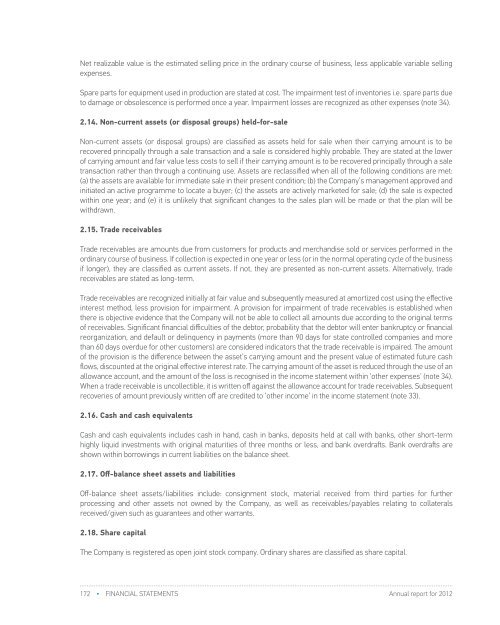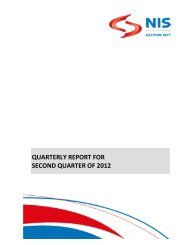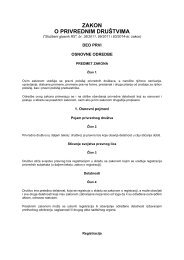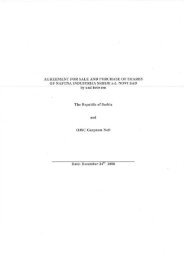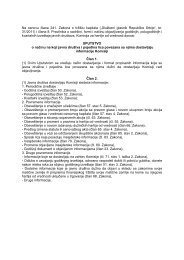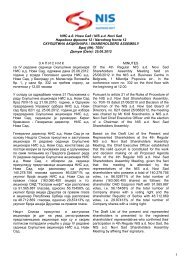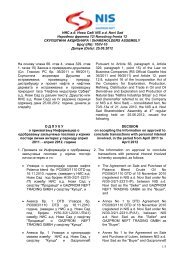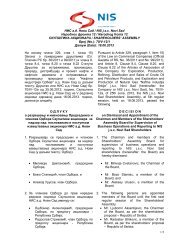FY 2012 - Investor Relations - NIS
FY 2012 - Investor Relations - NIS
FY 2012 - Investor Relations - NIS
Create successful ePaper yourself
Turn your PDF publications into a flip-book with our unique Google optimized e-Paper software.
Net realizable value is the estimated selling price in the ordinary course of business, less applicable variable sellingexpenses.Spare parts for equipment used in production are stated at cost. The impairment test of inventories i.e. spare parts dueto damage or obsolescence is performed once a year. Impairment losses are recognized as other expenses (note 34).2.14. Non-current assets (or disposal groups) held-for-saleNon-current assets (or disposal groups) are classified as assets held for sale when their carrying amount is to berecovered principally through a sale transaction and a sale is considered highly probable. They are stated at the lowerof carrying amount and fair value less costs to sell if their carrying amount is to be recovered principally through a saletransaction rather than through a continuing use. Assets are reclassified when all of the following conditions are met:(a) the assets are available for immediate sale in their present condition; (b) the Company’s management approved andinitiated an active programme to locate a buyer; (c) the assets are actively marketed for sale; (d) the sale is expectedwithin one year; and (e) it is unlikely that significant changes to the sales plan will be made or that the plan will bewithdrawn.2.15. Trade receivablesTrade receivables are amounts due from customers for products and merchandise sold or services performed in theordinary course of business. If collection is expected in one year or less (or in the normal operating cycle of the businessif longer), they are classified as current assets. If not, they are presented as non-current assets. Alternatively, tradereceivables are stated as long-term.Trade receivables are recognized initially at fair value and subsequently measured at amortized cost using the effectiveinterest method, less provision for impairment. A provision for impairment of trade receivables is established whenthere is objective evidence that the Company will not be able to collect all amounts due according to the original termsof receivables. Significant financial difficulties of the debtor, probability that the debtor will enter bankruptcy or financialreorganization, and default or delinquency in payments (more than 90 days for state controlled companies and morethan 60 days overdue for other customers) are considered indicators that the trade receivable is impaired. The amountof the provision is the difference between the asset’s carrying amount and the present value of estimated future cashflows, discounted at the original effective interest rate. The carrying amount of the asset is reduced through the use of anallowance account, and the amount of the loss is recognised in the income statement within ‘other expenses’ (note 34).When a trade receivable is uncollectible, it is written off against the allowance account for trade receivables. Subsequentrecoveries of amount previously written off are credited to ‘other income’ in the income statement (note 33).2.16. Cash and cash equivalentsCash and cash equivalents includes cash in hand, cash in banks, deposits held at call with banks, other short-termhighly liquid investments with original maturities of three months or less, and bank overdrafts. Bank overdrafts areshown within borrowings in current liabilities on the balance sheet.2.17. Off-balance sheet assets and liabilitiesOff-balance sheet assets/liabilities include: consignment stock, material received from third parties for furtherprocessing and other assets not owned by the Company, as well as receivables/payables relating to collateralsreceived/given such as guarantees and other warrants.2.18. Share capitalThe Company is registered as open joint stock company. Ordinary shares are classified as share capital.2.19. Other capitalOther capital in total refers to the Company’s capital above the amount of estimated and registered non-monetarycapital as at 31 May 2005. It was recognized as other capital.2.20. ReservesReserves fully relate to the reserves established in the past in accordance with the previous Law on Enterprises. Inaccordance with this Law, the Company was required to allocate 5% of profits until the reserve equals the amountdefined by Company’s Act, and at least 10% of the share capital.2.21. Earnings per shareThe Company calculates and discloses the basic earnings per share. Basic earnings per share is calculated by dividingthe net income that belongs to shareholders, the owners of ordinary shares of the Company, by the weighted averagenumber of ordinary shares issued during the period (note 36).2.22. ProvisionsProvisions for environmental restoration, asset retirement obligation, restructuring costs and legal claims arerecognised when: the Company has a present legal or constructive obligation as a result of past events; it is probablethat an outflow of resources will be required to settle the obligation; and the amount has been reliably estimated.Provisions are not recognised for future operating losses.Where there are a number of similar obligations, the likelihood that an outflow will be required in settlement isdetermined by considering the class of obligations as a whole. A provision is recognised even if the likelihood of anoutflow with respect to any one item included in the same class of obligations may be small.Provisions are measured at the present value of the expenditure expected to be required to settle the obligation using apre-tax rate that reflects current market assessments of the time value of money and the risks specific to the obligation.The increase in the provision due to passage of time is recognised as cost of provision and charged to income statement.2.23. BorrowingsBorrowings are recognised initially at fair value, net of transaction costs incurred. Borrowings are subsequently stated atamortised cost; any difference between the proceeds (net of transaction costs) and the redemption value is recognisedin the income statement over the period of the borrowings using the effective interest method.Fees paid on the establishment of loan facilities are recognised as transaction costs of the loan to the extent that itis probable that some or all of the facility will be drawn down. In this case, the fee is deferred until the draw-downoccurs. To the extent there is no evidence that it is probable that some or all of the facility will be drawn down, the fee iscapitalized as a prepayment for liquidity services and amortized over the period of the facility to which it relates.Borrowings are classified as current liabilities unless the Company has an unconditional right to defer settlement of theliability for at least 12 months after the reporting date.2.24. Trade payablesTrade payables are obligations to pay for goods or services that have been acquired in the ordinary course of businessfrom suppliers. Accounts payable are classified as current liabilities if payment is due within one year or less (or in thenormal operating cycle of the business if longer). If not, they are presented as non-current liabilities. Trade payablesare recognised initially at fair value and subsequently measured at amortised cost using the effective interest method.172 • FINANCIAL STATEMENTS Annual report for <strong>2012</strong>Annual report for <strong>2012</strong>FINANCIAL STATEMENTS • 173


